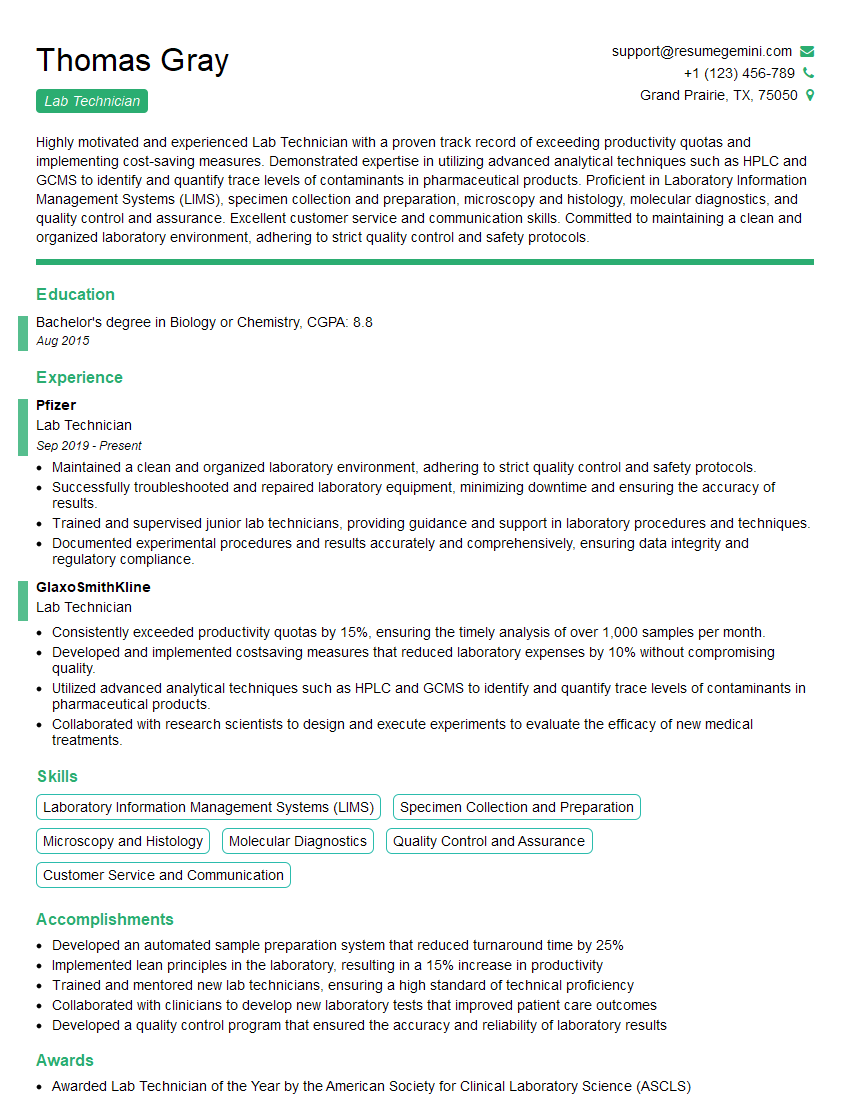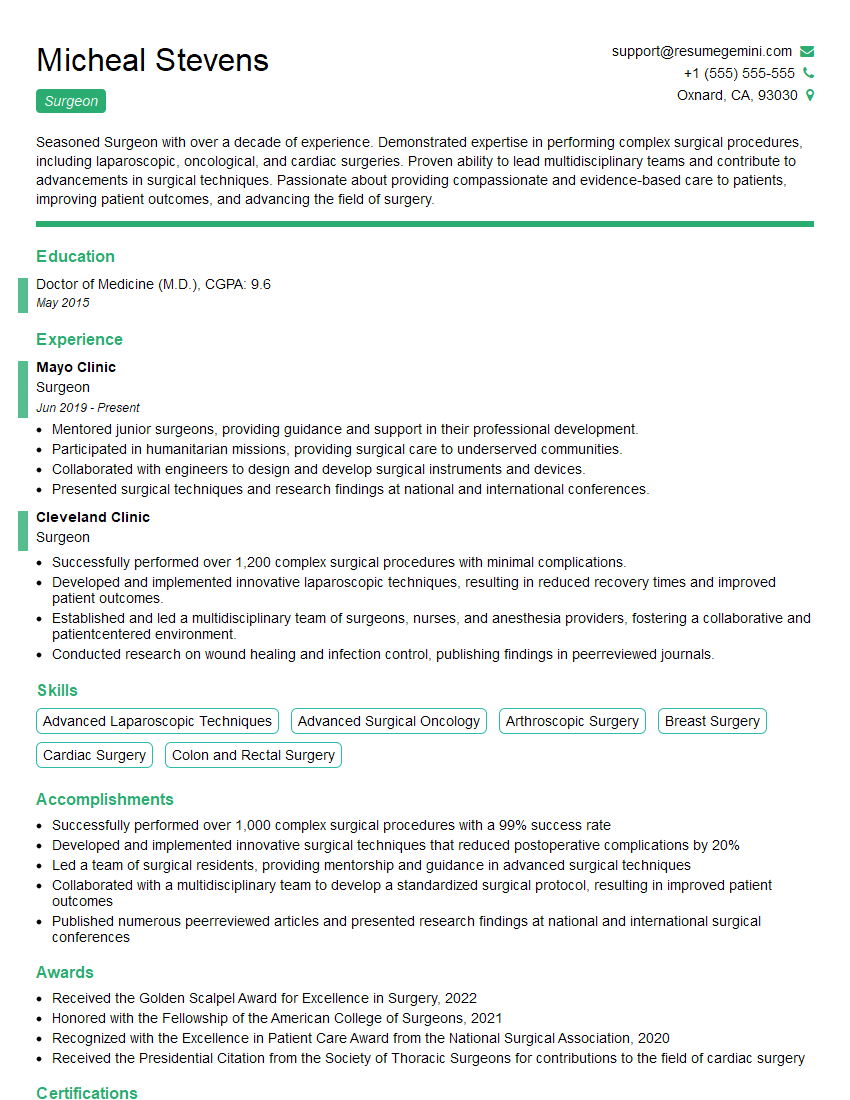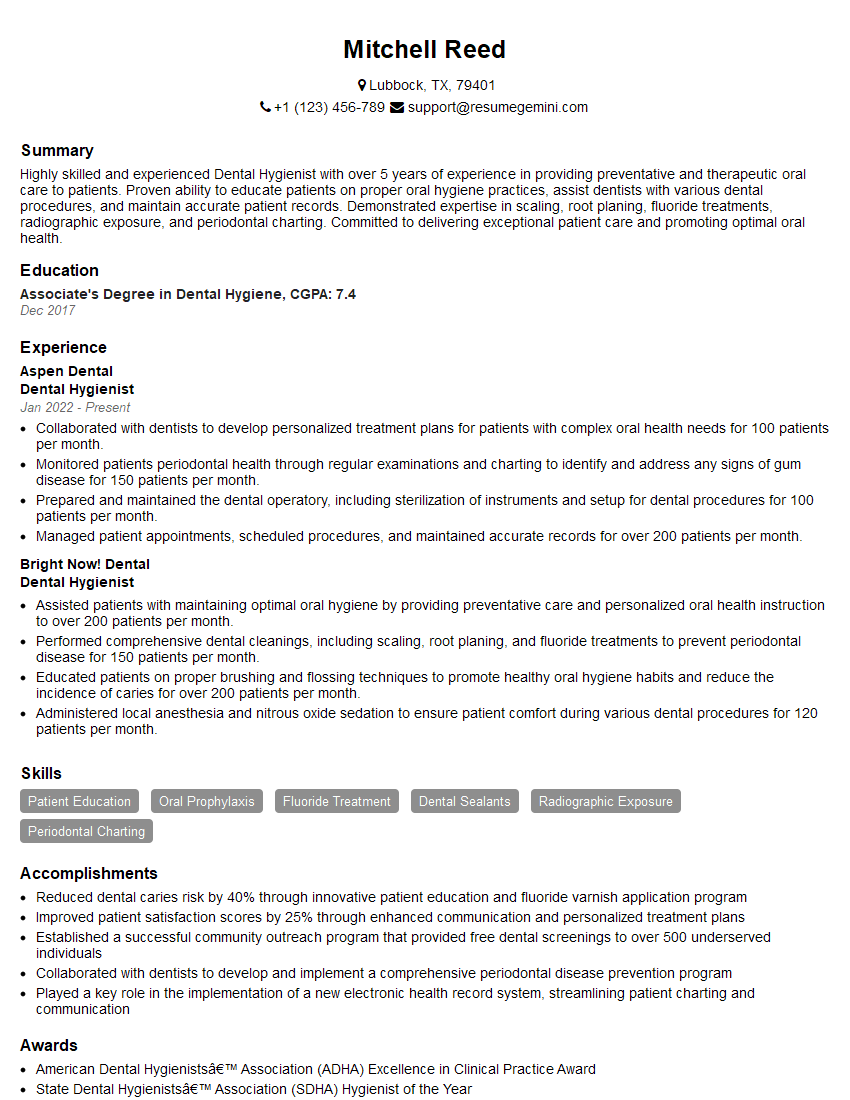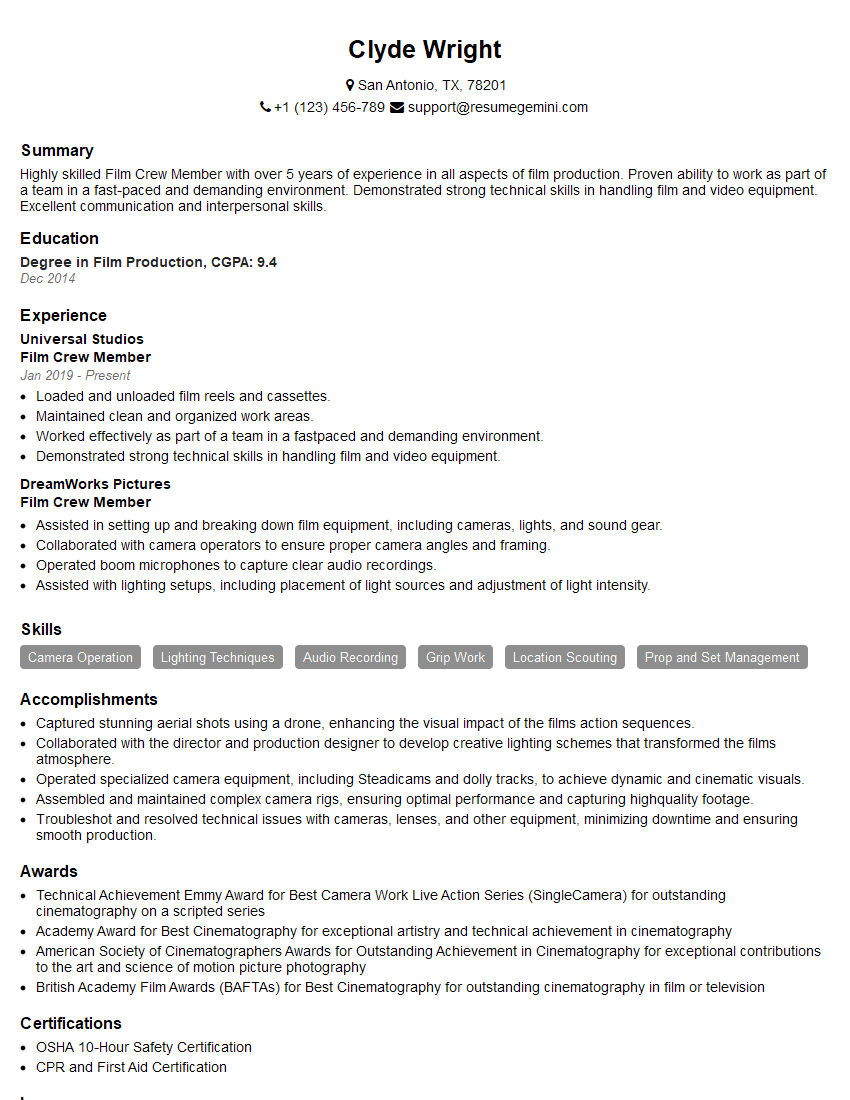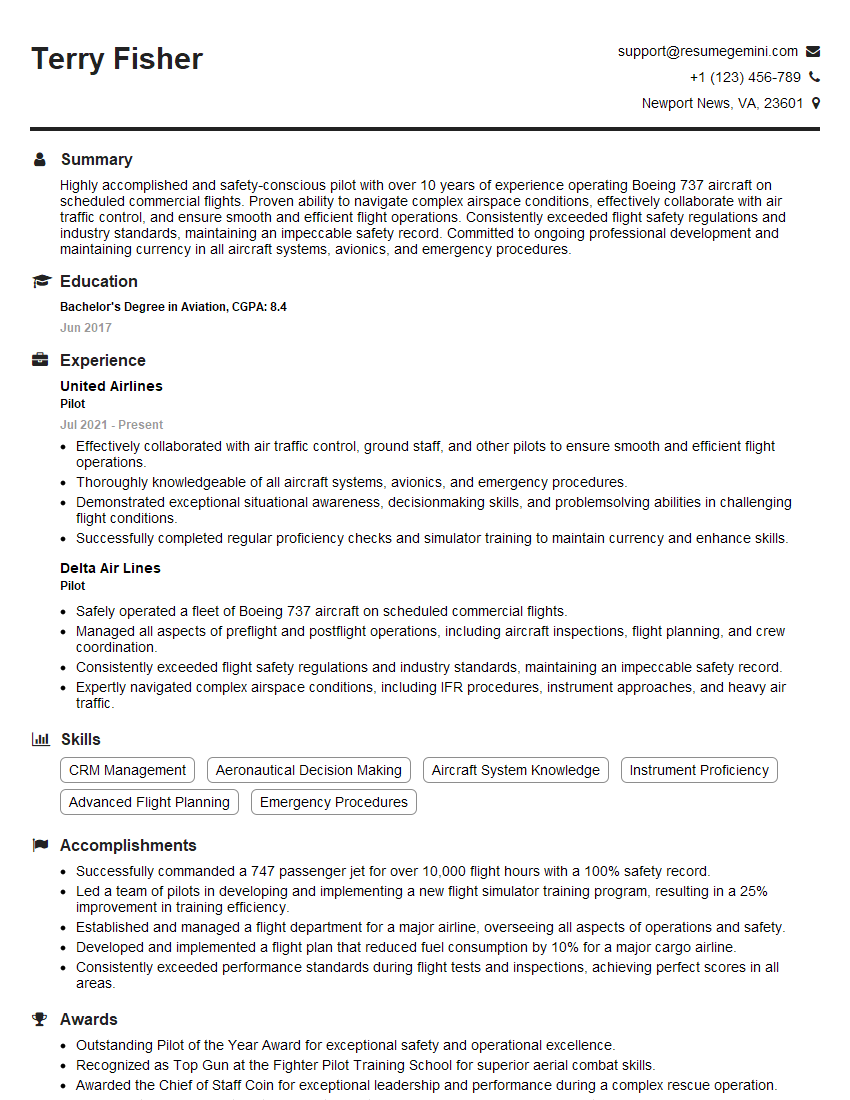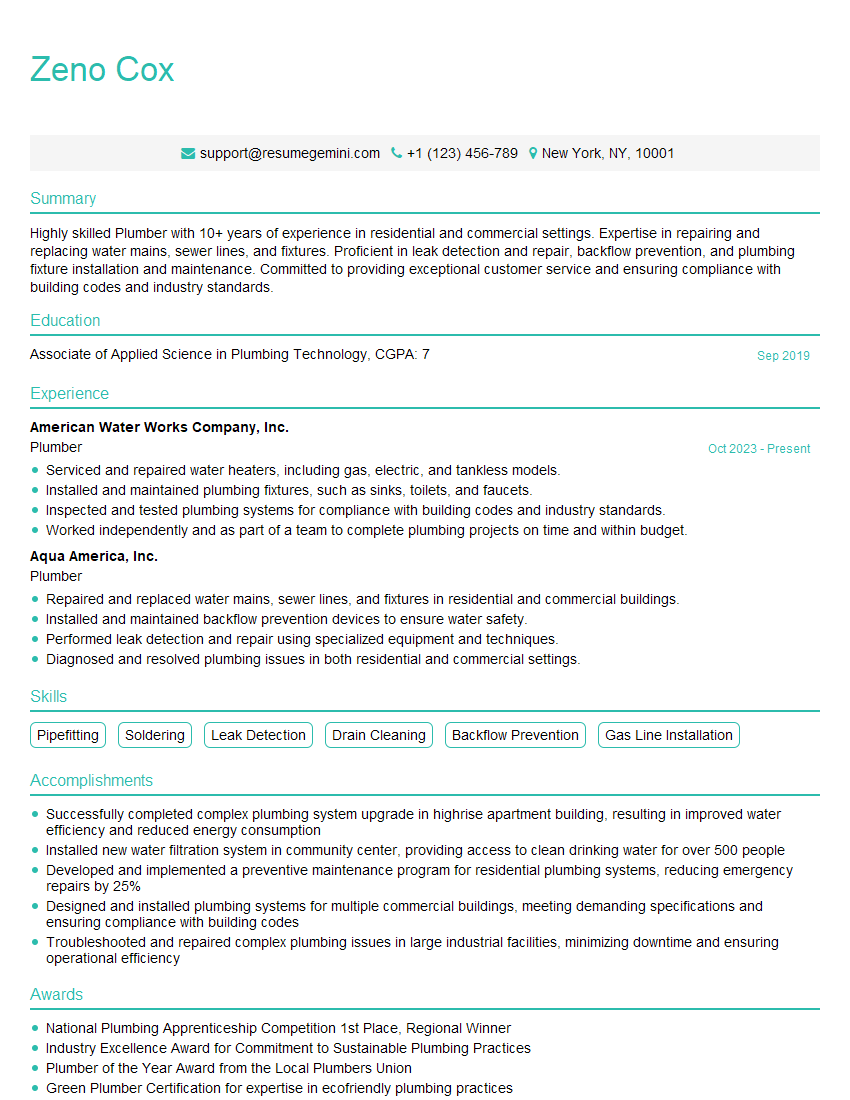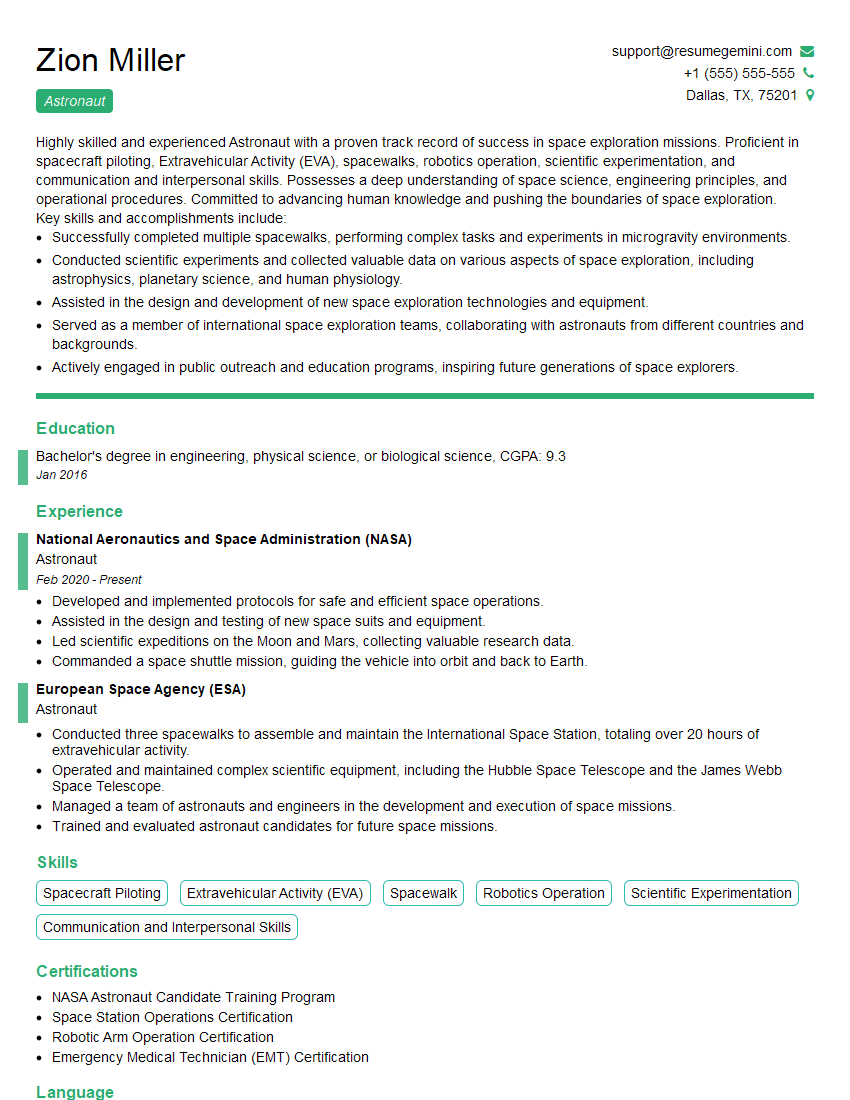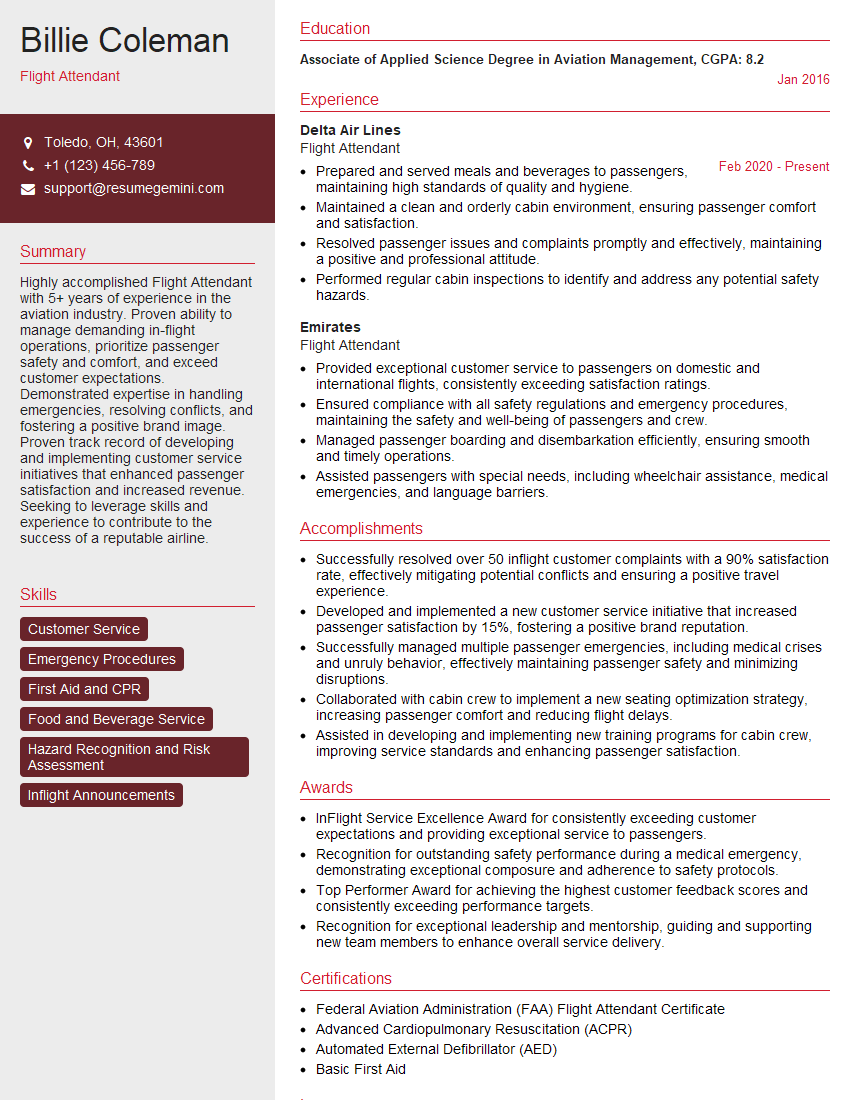Every successful interview starts with knowing what to expect. In this blog, we’ll take you through the top Ability to work in close quarters interview questions, breaking them down with expert tips to help you deliver impactful answers. Step into your next interview fully prepared and ready to succeed.
Questions Asked in Ability to work in close quarters Interview
Q 1. Describe a situation where you had to work effectively in a confined space.
During my time as a lead technician on a deep-sea submersible research project, we spent weeks working within the extremely confined space of the submersible’s control room. This involved coordinating complex equipment setups, troubleshooting malfunctions, and executing experiments all while sharing limited space with a team of four other specialists.
The challenges were numerous: limited maneuverability, restricted access to equipment, and the constant awareness of the surrounding pressure and depth. However, careful planning and a strong team dynamic allowed us to work effectively. We meticulously organized our workspace, assigning specific areas of responsibility to each team member, and developing a system for passing tools and equipment efficiently. This minimized unnecessary movement and potential collisions.
Q 2. How do you manage stress and maintain composure when working in close proximity to others for extended periods?
Maintaining composure in close quarters for extended periods requires proactive stress management techniques. Think of it like a marathon, not a sprint. I find that establishing clear roles and responsibilities within the team is crucial, preventing unnecessary overlap and conflicts that breed stress.
- Regular Breaks: Scheduled breaks, even short ones, are essential. Stepping out for fresh air, if possible, or simply taking a few moments for deep breathing exercises can greatly reduce tension.
- Open Communication: Creating an environment where team members feel comfortable expressing their concerns and frustrations prevents issues from escalating.
- Mindfulness and Self-Awareness: Practicing mindfulness techniques helps to manage emotional responses and react constructively rather than defensively in tense situations.
Essentially, it’s about fostering a culture of mutual respect and understanding, making the shared space a collaborative, rather than a stressful environment.
Q 3. Have you ever experienced a conflict while working in close quarters? How did you resolve it?
During a construction project involving a narrow, enclosed tunnel, a disagreement arose regarding the most efficient way to install ventilation equipment. One team member favored a more rapid approach, potentially jeopardizing safety, while another preferred a slower, more cautious method. The conflict stemmed from differing priorities: speed versus safety.
To resolve this, I facilitated a calm discussion, encouraging each individual to explain their reasoning and concerns. We then collaboratively brainstormed a solution that incorporated elements of both approaches, prioritizing safety without significantly impacting the timeline. This involved adjusting the installation sequence and implementing additional safety precautions. The outcome was a compromise that satisfied both parties and ensured the project proceeded safely and effectively.
Q 4. Describe your experience with safety protocols in confined spaces.
My experience with safety protocols in confined spaces is extensive, stemming from years in both industrial and research settings. I am certified in confined space entry and rescue, and my understanding goes beyond mere procedural knowledge. It involves a deep appreciation for the inherent risks.
- Permit-to-Work Systems: I’m proficient in using permit-to-work systems to ensure all necessary safety checks are completed before entering a confined space.
- Atmospheric Monitoring: I’m experienced in using gas detectors to monitor oxygen levels, combustible gases, and toxic substances.
- Emergency Procedures: I’m well-versed in emergency procedures, including rescue techniques and the use of emergency communication systems.
- Personal Protective Equipment (PPE): I understand the critical role of PPE and ensure all team members are properly equipped and trained in its use.
Safety is not merely a checklist, it’s a mindset. I always prioritize proactive risk assessment and communication.
Q 5. How do you ensure clear communication in a noisy or crowded environment?
Clear communication in a noisy or crowded environment requires strategies beyond simply shouting. It’s about optimizing both verbal and non-verbal communication.
- Visual Aids: Using visual aids like whiteboards, diagrams, or hand signals can significantly improve understanding, especially when auditory clarity is compromised.
- Pre-Planned Communication: Establishing pre-determined signals or short phrases for critical information can streamline communication and reduce ambiguity.
- Face-to-Face Communication: Whenever possible, I prioritize face-to-face communication to ensure both visual and auditory cues are present.
- Repeat and Confirm: I always repeat and confirm critical instructions or information to ensure accurate understanding.
Think of it like a game of charades; multiple methods of communication increase the chance of clear understanding.
Q 6. How do you adapt your work style to accommodate the physical limitations of a confined space?
Adapting my work style to the physical limitations of a confined space requires flexibility and a proactive approach. It’s about optimizing movements, using space efficiently, and anticipating constraints.
- Organized Workspace: Maintaining a highly organized workspace is essential to avoid unnecessary movement and potential collisions.
- Ergonomic Practices: I prioritize ergonomic practices to minimize strain and discomfort, given the limited space and often awkward postures.
- Compact Tools and Equipment: When possible, I opt for smaller, more compact tools and equipment to maximize space and maneuverability.
- Strategic Positioning: I strategically position myself and equipment to optimize workflow and minimize movements in the constrained environment.
Essentially, it’s about adopting a minimalist approach to optimize both movement and the use of the available workspace.
Q 7. What strategies do you use to maintain focus and efficiency in a distracting close-quarters environment?
Maintaining focus and efficiency in a distracting close-quarters environment relies on a combination of organizational skills and self-discipline.
- Time Blocking: I use time blocking to dedicate specific time slots to particular tasks, minimizing distractions and encouraging focused work.
- Task Prioritization: Prioritizing tasks ensures that the most important and urgent work is completed first, maximizing productivity and reducing stress.
- Minimizing Distractions: As much as possible, I actively minimize distractions such as unnecessary conversations or background noise.
- Regular Breaks: Scheduled breaks help to maintain focus and prevent mental fatigue. Even short breaks can dramatically increase productivity.
It’s a delicate balance of managing external factors and internal focus. It is essentially about optimizing your environment and your own work habits to produce high-quality work despite the limited and potentially distracting environment.
Q 8. Give an example of a time you had to share limited resources while working in a confined space.
Resource sharing in confined spaces requires meticulous planning and effective communication. Imagine working on a complex piece of machinery inside a small aircraft fuselage with a team of three. We had only one specialized torque wrench for tightening specific bolts. To avoid delays, we created a clear schedule, assigning time slots for each team member to use the tool, ensuring every task was completed efficiently and safely. This involved constant communication to anticipate needs and avoid any bottlenecks.
Another instance involved limited workspace in a submarine maintenance bay. We shared a single, specialized cleaning solution that was crucial for removing corrosion. We implemented a strict rotation system to prevent waste and ensure everyone had equal access. This required careful monitoring of consumption rates and proactive communication about any unexpected needs.
Q 9. How do you handle disagreements or differing opinions within a confined space team?
Disagreements are inevitable, especially in close quarters. My approach is to focus on collaborative problem-solving. I believe in fostering open communication where everyone feels comfortable expressing their opinions. When differences arise, I encourage active listening, ensuring everyone feels heard before presenting alternative solutions. This often involves prioritizing the shared goal and identifying common ground. We brainstorm options, weigh their pros and cons objectively, and select the best approach based on data and safety considerations. In highly confined situations, a respectful and solution-oriented approach is paramount to prevent conflict from escalating and to maintain team cohesion and efficiency.
Q 10. Explain your understanding of confined space safety regulations.
Confined space safety regulations are critical for preventing accidents and protecting workers. These regulations typically cover atmospheric monitoring (testing for oxygen levels, flammable gases, and toxins), entry permit systems (authorizing entry only after thorough risk assessments), rescue plans (ensuring swift evacuation in emergencies), and appropriate personal protective equipment (PPE). Understanding these regulations is not just about compliance; it’s about ensuring the safety of everyone working in the confined space. This includes knowing the hazards specific to the work being done, understanding the limitations of PPE, and being prepared for potential emergencies. For instance, I’m familiar with OSHA and similar international standards regarding confined space entry, permit-required confined space work procedures, and emergency response plans.
Q 11. Describe a time when you had to overcome a physical challenge while working in close quarters.
During a deep-sea oil rig repair, I faced a significant physical challenge. The space was extremely cramped, and I had to maneuver a large, heavy piece of equipment through a narrow passage while working in a difficult position for several hours. To overcome this, I used leverage and teamwork. We meticulously planned each move, using ropes and pulleys to assist in lifting and guiding the equipment. We utilized proper lifting techniques to prevent injury. By prioritizing teamwork and strategic planning, we completed the task without incident. Breaking down the task into smaller, manageable steps also helped in making the overall process more bearable.
Q 12. How do you maintain personal hygiene and space awareness in a confined workspace?
Maintaining personal hygiene and space awareness in confined workspaces is crucial. This includes regular handwashing, using appropriate deodorants, and wearing clean clothing. Space awareness involves being mindful of others and your movements to avoid collisions or accidental contact. In tight spaces, this is about communicating your movements to co-workers, taking extra care not to obstruct anyone’s work area, and always using proper lifting techniques to avoid injuries. For instance, I always check the surrounding area before moving any equipment or tools and clearly communicate my plans to other workers to prevent accidents.
Q 13. Have you ever worked with equipment requiring precision and coordination in a confined space?
Yes, I have extensive experience working with equipment requiring precision and coordination in confined spaces. For example, during a nuclear power plant maintenance project, we were tasked with replacing a delicate valve assembly within a narrow pipe. The task required meticulous alignment, and we used specialized tools and techniques to ensure accurate placement and proper sealing. This involved using highly sensitive measurement tools and a process that prioritized collaboration and a methodical approach. Effective communication and precision were absolutely critical given the high-stakes nature of the project and the confined workspace. Any mistake could have had severe consequences.
Q 14. How do you prevent accidents or injuries while working in close quarters?
Preventing accidents and injuries in close quarters necessitates a multifaceted approach. This begins with comprehensive risk assessments before any work begins, identifying potential hazards and implementing appropriate safety measures. This includes using proper lifting techniques, wearing appropriate safety equipment, and adhering to strict safety protocols and procedures. Regular communication among team members is also crucial for ensuring everyone is aware of potential hazards and can respond appropriately to unforeseen events. Furthermore, regular training and refresher courses on confined space safety procedures are essential to maintain high standards of safety awareness.
Q 15. Describe your experience working with a team in a high-pressure, confined space situation.
My experience working in high-pressure, confined spaces often involves collaborative efforts on underwater pipeline inspections. Imagine being inside a small submersible, several meters below the surface, with a team of three others, all focused on meticulously examining a pipeline for corrosion. The pressure is immense, not only from the depth but also from the critical nature of the task and the limited time available for the inspection. We rely on pre-planned roles, clear communication, and efficient workflows to ensure a successful mission. Each team member is responsible for specific tasks: one for visual inspection using advanced cameras, another for data logging and analysis, and a third for monitoring the submersible’s systems. My role typically involves overseeing the entire operation, coordinating tasks, and troubleshooting any issues that may arise in this challenging environment. The confined space necessitates a high level of trust and teamwork – a single mistake could have serious consequences.
Career Expert Tips:
- Ace those interviews! Prepare effectively by reviewing the Top 50 Most Common Interview Questions on ResumeGemini.
- Navigate your job search with confidence! Explore a wide range of Career Tips on ResumeGemini. Learn about common challenges and recommendations to overcome them.
- Craft the perfect resume! Master the Art of Resume Writing with ResumeGemini’s guide. Showcase your unique qualifications and achievements effectively.
- Don’t miss out on holiday savings! Build your dream resume with ResumeGemini’s ATS optimized templates.
Q 16. How do you adapt your communication style to the limitations of a confined space?
Communication in confined spaces requires a significant shift from typical office environments. We primarily rely on clear, concise verbal communication, minimizing unnecessary chatter. Non-verbal cues are crucial; a quick glance to confirm understanding or a subtle gesture to indicate a problem is often more efficient than lengthy explanations. Before entering the confined space, we establish clear communication protocols – hand signals for urgent issues, concise verbal updates on progress, and a designated point person to relay information to external teams. We also use pre-determined codes to address common issues or emergencies. For example, a code like ‘Alpha-One’ might signal a leak, immediately prompting a pre-defined response. The use of written communication is extremely limited, and only for critical data recording that might be difficult to relay verbally.
Q 17. What strategies do you employ to improve teamwork and coordination in tight spaces?
Improving teamwork and coordination in tight spaces demands meticulous planning and a strong emphasis on clear roles and responsibilities. Before any operation, we conduct thorough briefings, outlining each member’s role, potential challenges, and emergency procedures. We use checklists to ensure all necessary equipment and safety gear are present and accounted for. During the operation, consistent communication and regular status updates are paramount. We implement a system of cross-checks to minimize human error – for example, one person verifies another’s readings before recording the data. A shared understanding of the overall task and a proactive approach to problem-solving are also vital. We practice these procedures in simulated environments to build muscle memory and familiarity with the required steps. Consider it like a well-rehearsed orchestra; each musician knows their part and how it harmonizes with the others.
Q 18. How do you manage your emotional reactions in tense, close quarters situations?
Managing emotional reactions in tense situations requires self-awareness and well-developed coping mechanisms. High-pressure environments like confined spaces can exacerbate anxieties. Pre-operation mental preparation, including mindfulness exercises or deep breathing techniques, helps manage stress levels. Establishing a supportive team culture is crucial; open communication and mutual respect allow individuals to express concerns without fear of judgment. We encourage team members to take short breaks when necessary, even if it’s just a few seconds to regain composure. Recognizing personal stress triggers is vital, enabling individuals to develop strategies for managing these triggers effectively. A quick mental reset, such as focusing on a specific task or visualizing a positive outcome, can help restore focus and reduce stress.
Q 19. What measures do you take to ensure safety in a potentially hazardous confined space?
Safety in hazardous confined spaces is paramount. We always follow a strict protocol, beginning with a thorough risk assessment that identifies potential hazards and determines the necessary precautions. This includes checking atmospheric conditions for oxygen levels, flammable gases, and toxins before entry. Each team member wears appropriate personal protective equipment (PPE), including respirators, safety harnesses, and specialized clothing. We utilize monitoring equipment for continuous monitoring of atmospheric conditions and structural integrity within the confined space. Emergency procedures, including escape routes, emergency communication systems, and backup power supplies, are planned and practiced extensively. Regular safety training and drills reinforce procedures, ensuring everyone is prepared to react effectively in an emergency. Regular equipment checks are also vital to ensure that all safety gear remains in working condition.
Q 20. How do you handle claustrophobia or anxiety in confined spaces?
Addressing claustrophobia or anxiety in confined spaces requires a multi-faceted approach. Open communication is critical; team members should feel comfortable expressing concerns without fear of repercussions. Gradual desensitization, starting with shorter periods in simulated confined spaces and gradually increasing exposure, can be highly effective. Relaxation techniques like deep breathing and mindfulness exercises can help mitigate anxiety. In extreme cases, medication might be necessary, but this should be in consultation with medical professionals. The use of appropriate lighting and ventilation within the confined space can improve psychological comfort. Remember, proactive measures to manage anxiety are crucial. Creating a sense of shared responsibility for safety and wellbeing within the team contributes significantly to a positive experience.
Q 21. Explain your experience with emergency procedures in close quarters.
My experience with emergency procedures in close quarters centers around rigorous training and well-defined protocols. We regularly practice scenarios ranging from equipment malfunction to sudden atmospheric changes. Our training involves simulations that mirror real-world challenges, helping us build familiarity with the procedures and strengthen our teamwork. Emergency procedures are clearly communicated before each task, and everyone understands their roles in an emergency. This includes understanding escape routes, using emergency communication systems, and providing first aid if necessary. Our drills emphasize clear communication under duress, using pre-determined signals and verbal commands to avoid confusion. We use real-world examples and case studies to familiarize ourselves with potential scenarios and improve our decision-making in a crisis. The key is not just to know the protocols, but to understand how and why they are important, thus ensuring readiness and effective responses.
Q 22. How do you maintain a professional demeanor while working in close proximity with others?
Maintaining professionalism in close quarters requires a conscious effort to be respectful of personal space and mindful of your actions. It’s about practicing good communication and demonstrating consideration for your colleagues. Think of it like a well-choreographed dance – everyone needs to know their steps and respect the space of others.
- Clear Communication: Openly communicate your needs and expectations, avoiding assumptions. For instance, if you need some quiet time to concentrate, politely let your colleagues know.
- Respectful Boundaries: Maintain appropriate personal space. Avoid invading a colleague’s workspace unnecessarily or making sudden movements that might startle them.
- Active Listening: Pay attention when colleagues are speaking, showing you value their contributions and opinions.
- Professional Attire and Hygiene: Maintaining a clean and professional appearance demonstrates respect for yourself and your colleagues.
In a shared office, for example, I would always announce my intention to make a call, making sure to minimize noise and keep the duration of my call brief. I also make sure to clean up my space frequently to maintain a shared sense of order and cleanliness.
Q 23. Describe a time you had to compromise to accommodate the needs of others in a confined space.
During a particularly hectic project launch, our team of five was working in a cramped server room. One colleague, let’s call him Mark, needed consistent access to a specific rack for monitoring system performance. However, I was also heavily reliant on that same rack for troubleshooting a critical network issue. The space was so tight that only one person could comfortably work on the rack at a time.
To resolve this, we compromised by creating a schedule. Mark would have priority access during the critical monitoring periods, and I would take over when the network issue required urgent attention. This required clear communication and flexibility from both of us, but it ensured that both tasks were completed efficiently without causing delays.
Q 24. How do you utilize technology effectively in a limited-space workspace?
Technology is crucial for optimizing limited space workspaces. It’s about leveraging tools that minimize physical clutter and enhance collaboration. Think of it like Tetris – fitting as much functionality into the limited space as possible.
- Cloud Storage: Utilizing cloud storage services like Google Drive or Dropbox eliminates the need for large physical storage devices.
- Virtual Collaboration Tools: Tools like Slack, Microsoft Teams, or Zoom facilitate seamless communication and collaboration, reducing the need for lengthy in-person meetings.
- Portable Devices: Using laptops and tablets instead of bulky desktop computers saves valuable desk space.
- Vertical Space Optimization: Mounting monitors on arms allows for more efficient use of desk space. Using monitor mounts, keyboard trays, and under-desk storage systems maximizes the limited space.
For example, in previous roles, we transitioned to a fully cloud-based document management system, freeing up significant cabinet and desk space while simultaneously improving team access and collaboration.
Q 25. Have you ever dealt with a malfunctioning piece of equipment in a confined space?
Yes, once while working on a subsea cable repair vessel, a critical piece of testing equipment malfunctioned in a small, cramped equipment room. The room was only large enough to accommodate the equipment and two technicians comfortably.
Firstly, we followed the established safety protocols – shutting down power and ensuring the area was secure. Then, we systematically troubleshooted the problem, utilizing remote diagnostics and our manufacturer’s troubleshooting documentation. Because of the confined space, we had to be incredibly precise and cautious in our movements to avoid accidental damage to other equipment. Working methodically and prioritizing safety allowed us to identify the issue (a faulty power supply) and find a temporary fix, ensuring minimal project disruption.
Q 26. How do you effectively delegate tasks in a confined space team setting?
Effective delegation in close quarters requires clear communication, defined roles, and a collaborative spirit. It’s about orchestrating teamwork in a small space.
- Clear Task Definition: Ensure tasks are clearly defined with specific objectives and expected outcomes.
- Skill Matching: Assign tasks to team members based on their skills and expertise.
- Regular Check-ins: Frequent updates and check-ins prevent misunderstandings and keep everyone on track.
- Open Communication Channels: Create a system for open communication such as using a shared digital whiteboard or a project management tool to ensure tasks are clear and progress is visible to everyone.
For instance, when managing a small team working in a shared design studio, I would utilize a project management software to assign tasks, track progress, and facilitate clear communication, minimizing disruption and maximizing efficiency.
Q 27. Describe a time when your ability to work in close quarters significantly impacted a project’s success.
During a rapid prototyping phase for a new medical device, our team of three engineers worked in a small, shared lab. Space was incredibly limited, and we were under immense pressure to deliver a functional prototype quickly. My ability to work effectively in close quarters was instrumental in the project’s success.
My experience allowed me to proactively organize our workspace, ensuring efficient workflow and minimizing wasted movement. I also helped mediate any disagreements or misunderstandings, leveraging my collaborative skills to maintain team morale and productivity even under stress. This collaborative spirit, combined with efficient use of the shared space, allowed us to deliver a fully functional prototype ahead of schedule.
Key Topics to Learn for Ability to Work in Close Quarters Interview
- Effective Communication: Understanding and employing clear, concise, and respectful communication strategies in shared workspaces. This includes active listening, non-verbal cues, and conflict resolution techniques.
- Respect for Personal Space: Recognizing and respecting individual needs for personal space and boundaries. This involves understanding different comfort levels and adjusting your behavior accordingly.
- Teamwork & Collaboration: Demonstrating the ability to work harmoniously within a team, sharing resources efficiently, and contributing positively to a collaborative environment, even in physically constrained settings.
- Adaptability & Flexibility: Showcasing your ability to adjust to changing circumstances, unexpected interruptions, and the close proximity of colleagues, maintaining composure and productivity.
- Problem-Solving in Shared Spaces: Highlighting your ability to identify and resolve conflicts or logistical challenges that might arise from working in close quarters, offering proactive solutions.
- Hygiene & Professionalism: Maintaining a high standard of personal hygiene and professional conduct, ensuring a clean and respectful shared workspace.
- Time Management & Organization: Demonstrating efficient time management and organizational skills to minimize disruption and maximize productivity in a shared workspace.
Next Steps
Mastering the ability to work effectively in close quarters is crucial for career advancement in many professional fields. It demonstrates essential teamwork, communication, and adaptability skills highly valued by employers. Building an ATS-friendly resume that highlights these skills is key to increasing your job prospects. To create a compelling and effective resume that showcases your abilities, we encourage you to use ResumeGemini. ResumeGemini offers a powerful platform to build a professional resume, and we provide examples of resumes tailored to highlight “Ability to work in close quarters” to guide you.
Explore more articles
Users Rating of Our Blogs
Share Your Experience
We value your feedback! Please rate our content and share your thoughts (optional).
What Readers Say About Our Blog
This was kind of a unique content I found around the specialized skills. Very helpful questions and good detailed answers.
Very Helpful blog, thank you Interviewgemini team.


